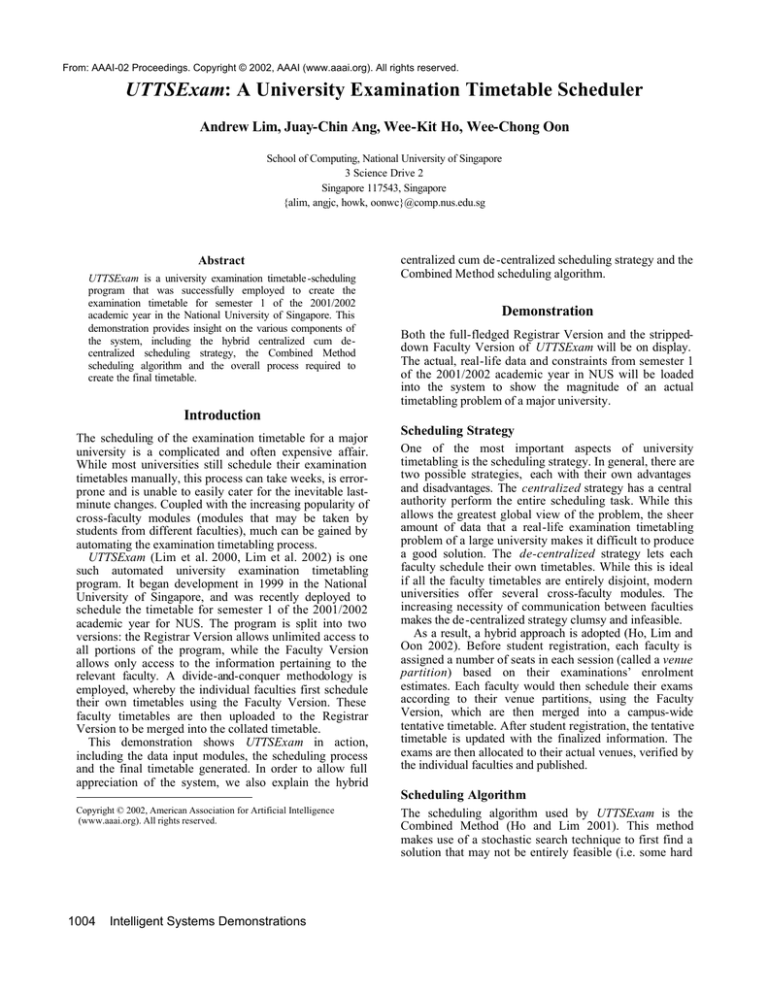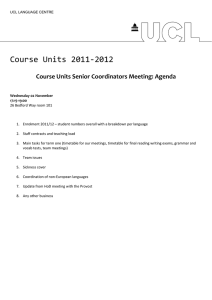
From: AAAI-02 Proceedings. Copyright © 2002, AAAI (www.aaai.org). All rights reserved.
UTTSExam: A University Examination Timetable Scheduler
Andrew Lim, Juay-Chin Ang, Wee-Kit Ho, Wee-Chong Oon
School of Computing, National University of Singapore
3 Science Drive 2
Singapore 117543, Singapore
{alim, angjc, howk, oonwc}@comp.nus.edu.sg
Abstract
UTTSExam is a university examination timetable -scheduling
program that was successfully employed to create the
examination timetable for semester 1 of the 2001/2002
academic year in the National University of Singapore. This
demonstration provides insight on the various components of
the system, including the hybrid centralized cum decentralized scheduling strategy, the Combined Method
scheduling algorithm and the overall process required to
create the final timetable.
centralized cum de -centralized scheduling strategy and the
Combined Method scheduling algorithm.
Demonstration
Both the full-fledged Registrar Version and the strippeddown Faculty Version of UTTSExam will be on display.
The actual, real-life data and constraints from semester 1
of the 2001/2002 academic year in NUS will be loaded
into the system to show the magnitude of an actual
timetabling problem of a major university.
Introduction
The scheduling of the examination timetable for a major
university is a complicated and often expensive affair.
While most universities still schedule their examination
timetables manually, this process can take weeks, is errorprone and is unable to easily cater for the inevitable lastminute changes. Coupled with the increasing popularity of
cross-faculty modules (modules that may be taken by
students from different faculties), much can be gained by
automating the examination timetabling process.
UTTSExam (Lim et al. 2000, Lim et al. 2002) is one
such automated university examination timetabling
program. It began development in 1999 in the National
University of Singapore, and was recently deployed to
schedule the timetable for semester 1 of the 2001/2002
academic year for NUS. The program is split into two
versions: the Registrar Version allows unlimited access to
all portions of the program, while the Faculty Version
allows only access to the information pertaining to the
relevant faculty. A divide-and-conquer methodology is
employed, whereby the individual faculties first schedule
their own timetables using the Faculty Version. These
faculty timetables are then uploaded to the Registrar
Version to be merged into the collated timetable.
This demonstration shows UTTSExam in action,
including the data input modules, the scheduling process
and the final timetable generated. In order to allow full
appreciation of the system, we also explain the hybrid
Scheduling Strategy
One of the most important aspects of university
timetabling is the scheduling strategy. In general, there are
two possible strategies, each with their own advantages
and disadvantages. The centralized strategy has a central
authority perform the entire scheduling task. While this
allows the greatest global view of the problem, the sheer
amount of data that a real-life examination timetabling
problem of a large university makes it difficult to produce
a good solution. The de-centralized strategy lets each
faculty schedule their own timetables. While this is ideal
if all the faculty timetables are entirely disjoint, modern
universities offer several cross-faculty modules. The
increasing necessity of communication between faculties
makes the de -centralized strategy clumsy and infeasible.
As a result, a hybrid approach is adopted (Ho, Lim and
Oon 2002). Before student registration, each faculty is
assigned a number of seats in each session (called a venue
partition) based on their examinations’ enrolment
estimates. Each faculty would then schedule their exams
according to their venue partitions, using the Faculty
Version, which are then merged into a campus-wide
tentative timetable. After student registration, the tentative
timetable is updated with the finalized information. The
exams are then allocated to their actual venues, verified by
the individual faculties and published.
Scheduling Algorithm
Copyright © 2002, American Association for Artificial Intelligence
(www.aaai.org). All rights reserved.
1004
Intelligent Systems Demonstrations
The scheduling algorithm used by UTTSExam is the
Combined Method (Ho and Lim 2001). This method
makes use of a stochastic search technique to first find a
solution that may not be entirely feasible (i.e. some hard
constraints may be violated) but is of high quality in terms
of a weighted sum of the different constraints satisfied.
This solution is then used to guide a selection algorithm
with consistency checking to create a feasible timetable
that still retains most of the quality of the initial solution.
UTTSExam employs the Genetic Algorithm (Marin
1998) as its stochastic search technique, with Tabu Search
(Rayward-Smith et al. 1996) post-optimization. This
guides the Variable Ordering Method with AC -3
(Mackworth 1977) consistency checking.
timetable for a major university. This demonstration seeks
to reveal how the various techniques employed have been
incorporated into a coherent whole. Admittedly, university
examination timetabling is an immensely complex and
tedious process to automate, but the potential benefits are
similarly tremendous. We hope to show that the
automation of university examination timetabling is well
worth the effort.
Application Modules
Ho, W. K. and Lim, A. A Hybrid-Based Framework for
Constraint Satisfaction Optimization Problems , in
International Conference on Information Systems (ICIS)
2001, pg. 65-76.
The UTTSExam program is made up of several parts.
Several modules allow the input of information, including
examination, student, venue and session information. Of
particular interest is the input on constraint information,
which is a crucial part of any timetabling system. The
system allows:
• Unary constraints (e.g. paper X is to be held in
venue V),
• Binary constraints (e.g. paper X must be at least 3
sessions before paper Y),
• Inter-group constraints (e.g. all papers in group A
must be before all papers in group B), and
• Intra-group constraints (e.g. the papers in group A
must be at least 2 sessions apart).
Additionally, UTTSExam allows output of all the
internal information in the form of html files for ready
display on the university web pages. There are also tools
for defining the venue layouts and the assignment of seat
numbers to each candidate.
Benefits
When compared to the only alternative of manual
scheduling, automated timetable scheduling offers
tremendous benefits.
• Manual scheduling usually takes several weeks to
complete. UTTSExam takes only a few minutes.
• The timetable generated by UTTSExam required
fewer days and sessions than those created using
the previous manual system. Since some of the
examinations are held in commercial venues that
require rental, this translates to a substantial
monetary saving.
• Previous manual timetables often contain
overlooked constraint conflicts. The automated
timetable is conflict-free.
• UTTSExam can easily handle last-minute changes
to the data.
• In the future, administrators can use the system to
test the feasibility of possible policy changes,
like the shortening of the examination period.
References
Ho, W. K.; Lim, A.; and Oon, W. C. UTTSExam: A
University Examination Timetabling System, submitted
to IEEE Intelligent Systems 2002.
Lim, A.; Ang, J. C.; Ho, W. K.; and Oon, W. C. A CampusWide University Examination Timetabling Application,
in Innovative Applications in Artificial Intelligence
(AAAI/IAAI) 2000, pg. 1020-1025
Lim, A.; Ang, J. C.; Ho, W. K.; and Oon, W. C.
UTTSExam: A Campus-Wide University ExaminationTimetabling System, submitted to Innovative Applications
in Artificial Intelligence (AAAI/IAAI) 2002
Mackworth, A. K. Consistency in Networks of Relations,
in Artificial Intelligence 8 (1977): 88-119
Marin, H. T. “Combinations of GA and CSP Strategies for
Solving the Examination Timetabling Problem”, Ph.D.
thesis, Instiuto Technologico y de Estudios Superiores
de Menterrey, 1998.
Rayward-Smith, V. J.; Osman, I. H.; Reeves, C. R.; and
Smith, G. D. Modern Heuristic Search Methods, 1996.
Conclusion
UTTSExam is a university examination timetable
scheduler that has been successfully used to create the
Intelligent Systems Demonstrations
1005



